

DIY Food Forest Herb Plantings - An Open Source Archive. Highest Good Network and Community Project Management Software. Highest Good of All Global Transformation Pledge. The One Community Highest Good of All Pledge is 14 core values and 46 questions we use as our foundation for facilitating a global shift to a world that works for everyone.
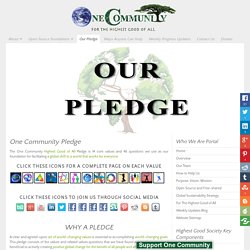
A clear and agreed-upon set of world-changing values is essential to accomplishing world-changing goals. This pledge consists of the values and related values questions that we have found as most important and beneficial to actively creating positive global change for the benefit of all people and all life on this planet. Every core team member of One Community signs this pledge. Signing this pledge is our agreement to use the questions below, and the values as defined here and in more depth on the individual pages, as the compass for all our decision making.
This helps us help each other “be the change we want to see in the world” through remembering and implementing these values on a personal and group level every day. . ~ The Highest Good of All ~ Tomatoes: Cultural Considerations. This page is an open source resource guide for tomatoes.
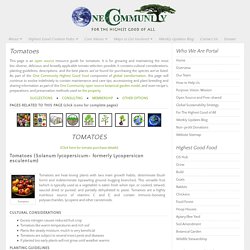
It is for growing and maintaining the most bio-diverse, delicious, and broadly applicable tomato selection possible. It contains cultural considerations, planting guidelines, descriptions, and the best places we’ve found for purchasing the species we’ve listed. Turnips: Cultural Considerations. Peas: Cultural Considerations. This page is an open source resource guide for peas.
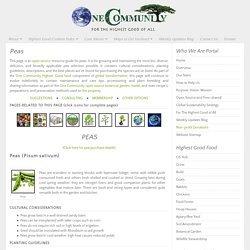
It is for growing and maintaining the most bio-diverse, delicious, and broadly applicable pea selection possible. It contains cultural considerations, planting guidelines, descriptions, and the best places we’ve found for purchasing the species we’ve listed. As part of the One Community Highest Good food component of global transformation, this page will continue to evolve indefinitely to contain maintenance and care tips, accessioning and plant breeding and sharing information as part of the One Community open source botanical garden model, and even recipe’s, preparations, and preservation methods used on the property.
PAGES RELATED TO THIS PAGE (click icons for complete pages) Peas (Pisum sativum) Peas should be planted as early in spring as possible while avoiding frost. Wikipedia – Peas We will also be growing the following additional peas: Squash: Cultural Considerations. This page is an open source resource guide for squash.
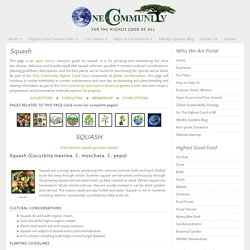
It is for growing and maintaining the most bio-diverse, delicious, and broadly applicable squash selection possible. It contains cultural considerations, planting guidelines, descriptions, and the best places we’ve found for purchasing the species we’ve listed. As part of the One Community Highest Good food component of global transformation, this page will continue to evolve indefinitely to contain maintenance and care tips, accessioning and plant breeding and sharing information as part of the One Community open source botanical garden model, and even recipe’s, preparations, and preservation methods used on the property.
PAGES RELATED TO THIS PAGE (click icons for complete pages) Squash (Cucurbita maxima, C. moschata, C. pepo) Celery/Celeriac: Cultural Considerations. Beets: Cultural Considerations. This page is an open source resource guide for beets.
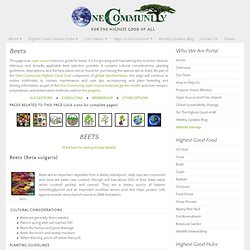
It is for growing and maintaining the most bio-diverse, delicious, and broadly applicable beet selection possible. It contains cultural considerations, planting guidelines, descriptions, and the best places we’ve found for purchasing the species we’ve listed. As part of the One Community Highest Good food component of global transformation, this page will continue to evolve indefinitely to contain maintenance and care tips, accessioning and plant breeding and sharing information as part of the One Community open source botanical garden model, and even recipe’s, preparations, and preservation methods used on the property.
PAGES RELATED TO THIS PAGE (click icons for complete pages) Beets (Beta vulgaris) Beets are generally direct seededPlant in spring after soil reaches 55FBeets like humus and good drainageBeets like mulch and steady moistureWhen thinning, pinch off rather than pull Wikipedia – Beets Beet Plant Material/Seed Providers: Highest Good Food: Walipinis. One Community wants to help people to grow their own high quality and diverse food.
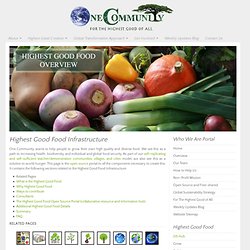
We see this as a path to increasing health, biodiversity, and individual and global food security. As part of our self-replicating and self-sufficient teacher/demonstration communities, villages, and cities model, we also see this as a solution to world hunger. This page is the open source portal to all the components necessary to create this. It contains the following sections related to the Highest Good Food Infrastructure:
Potters Without Borders « Ceramic Pot Filters treat water borne disease. Potters Without Borders. Kingbird Farm - Layer Hen Breeding (1 of 2) Conscientious Animal Husbandry: Rabbits. Rotary Hydroponic Gardens Volksgarden® Welcome to Your Indoor Garden!
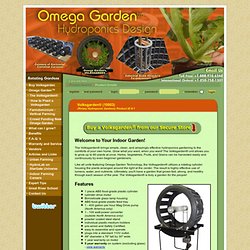
The Volksgarden® brings simple, clean, and amazingly effective hydroponics gardening to the comforts of your own home. Grow what you want, when you want! The Volksgarden® unit allows you to grow up to 80 plants at once. Herbs, Vegetables, Fruits, and Grains can be harvested easily and continuously by even beginner gardeners. Like all units featuring Omega Garden Technology, the Volksgarden® utilizes a rotating cylinder housing the plants arranged around the light at the center. 2008 Lawton Establishing a Food Forest the Permaculture Way. One Community Partners ~ Working Together for a Better Future.
One Community seeks to create and strengthen win-win relationships with other forward-thinking people and organizations throughout the world. Our purpose is to work with those who agree with our four-phase global change strategy and desire to help us in our mission to demonstrate and open source free-share all that we do to provide non-profit leadership and a blueprint for global living for The Highest Good of All. The like-minded individuals and organizations below are the people we are working with now, and will proudly refer everyone to in the future, as our model continues to evolve and expand globally. Amber Berg - PhD Eco-applied Psychology & Licensed Acupuncturist: Dedicated to healthy living and the environment, Amber has a diverse background of education and experience in both fields.
She has a PhD of Eco-Applied Psychology, Masters of Science in Oriental Medicine, Bachelor of Arts in Animal Behavioral Psychology degree, and is a Licensed Acupuncturist. Dr. Aquapini and Walipini Open Source Hub. As part of One Community’s four-phase strategy and global change methodology, our initial food infrastructure is an open source project-launch blueprinting of 6 structures that will represent 3 different aquapini and walipini designs. These 6 structures will be a part of our botanical garden model and will produce a diversity of delicious and nutritious food far beyond anything found in a typical grocery store. This open source hub includes the following sections: A walipini is an in-ground food production structure. An aquapini is a walipini incorporating aquaponics.
These structures are built into the ground because below the frost line the earth maintains a temperature of 55 degrees F/13 C. Vermicomposting.com: Home of Worm Composting. Api.ning.com/files/i5yJPLRlV1NcfDG65vycOCMqcT2qr83V7I98IUFrkF-HmG6BE77JhjhJwLVu3DteJGad*SzSBDGe7NBhZg5eeCi5TG2iv2FJ/MyOllaIrrigationSystemExplained.pdf. Www.gallifreypermaculture.com.au/wp-content/uploads/2012/11/Ollas.pdf. Www.gallifreypermaculture.com.au/wp-content/uploads/2012/11/Ollas.pdf.